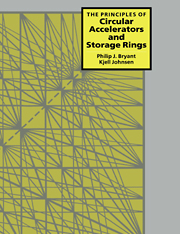Book contents
- Frontmatter
- Contents
- Foreword
- Coordinate system
- Symbols
- Useful Constants
- 1 Introduction
- 2 Basic concepts and constant-gradient focusing
- 3 Alternating-gradient focusing
- 4 Parameterisation of the transverse motion
- 5 Imperfections and resonances
- 6 Chromaticity
- 7 Longitudinal beam dynamics
- 8 Image and space-charge forces (transverse)
- 9 Coherent instabilities
- 10 Radiating particles
- 11 Diagnosis and compensation
- 12 Special aspects of circular colliders
- Appendix A Transverse particle motion in an accelerator
- Appendix B Accelerator magnets
- Appendix C Closed orbits
- Appendix D Phase equation
- Appendix E Vlasov equation
- References
- Index
Appendix B - Accelerator magnets
Published online by Cambridge University Press: 11 November 2009
- Frontmatter
- Contents
- Foreword
- Coordinate system
- Symbols
- Useful Constants
- 1 Introduction
- 2 Basic concepts and constant-gradient focusing
- 3 Alternating-gradient focusing
- 4 Parameterisation of the transverse motion
- 5 Imperfections and resonances
- 6 Chromaticity
- 7 Longitudinal beam dynamics
- 8 Image and space-charge forces (transverse)
- 9 Coherent instabilities
- 10 Radiating particles
- 11 Diagnosis and compensation
- 12 Special aspects of circular colliders
- Appendix A Transverse particle motion in an accelerator
- Appendix B Accelerator magnets
- Appendix C Closed orbits
- Appendix D Phase equation
- Appendix E Vlasov equation
- References
- Index
Summary
In Chapters 2 and 3 the analysis of the particle motion is developed in the environment of sharply defined regions of constant dipole and quadrupole fields. Real-world magnets are more complicated.
Multipole expansion of a 2-dimensional magnetic field
First consider a purely 2-dimensional field, which is a rather reasonable approximation since the majority of accelerator magnets are long compared with their aperture. In the source-free region of the magnet gap, the field can be derived from a scalar potential φ. In the local cylindrical coordinate system for the magnet, the general Fourier expansion of this scalar potential will be,
where, Am and Bm are constants. The zero order term is a constant and can be disregarded, since it will make no contribution to the fields derived later. Equation (1B) contains two orthogonal sets of multipoles;
the sine terms are designated normal or right multipoles, and
the cosine terms are designated skew multipoles.
An alternating-gradient lattice has two normal modes for particle oscillations and by using only normal lenses these modes are made horizontal and vertical. As discussed in Chapter 5 the inclusion of skew lenses in a normal lattice will cause coupling between these modes. It is clear from (1B) that the skew multipoles can be made by simply rotating the normal multipoles by π/(2m).
Equation (1B) is a natural starting point in a mathematical sense, but is slightly inconvenient for certain applications.
- Type
- Chapter
- Information
- The Principles of Circular Accelerators and Storage Rings , pp. 317 - 327Publisher: Cambridge University PressPrint publication year: 1993



